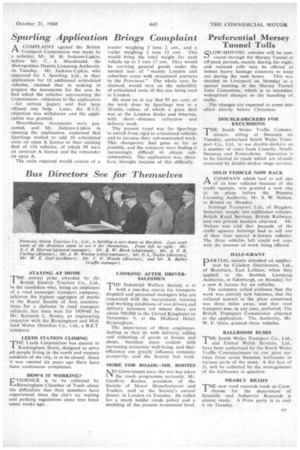Spurling Application Brings Complaint
Page 43

If you've noticed an error in this article please click here to report it so we can fix it.
A COMPLAINT against the British r-1 Transport. Commission was made by a solicitor, Mr. M. H. Jackson-Lipkin, before Mr. C. J. Macdonald, the Metropolitan DepLity Licensing Authority, on Tuesday. Mr. Jackson-Lipkin, who appeared. for J. Spurting, Ltd., in their application for 10 ,aelditional articulated vehicles, claimed that in seeking to prepare the documents for the case he had asked the solicitor representing the Commission—objectors to the application --for certain papers and had been refused any help. Later, the B.T.C. objection was withdrawn and the application was granted.
Nevertheless, documents were presented, and Mr. Jackson-Lipkin in opening the application, explained that Spurlings wished to add 10 articulated units on open A licence to their existing fleet of 154 vehicles, of which 99 were on contract A licence and the remainder on open A.
The units required would consist of a tractor weighing 3 tons 2 cwt., and a trailer weighing 2 tons 15 cwt. This would bring the total weight for each vehicle up to 5 tons 17 cwt. They would be carrying general goods under the normal user of "mainly London and suburban areas with occasional journeys to the Provinces." The whole case, he claimed, would turn on the suitability of articulated units of this size being used in London, He went on to say that 95 per cent, of the work done by Spurlings was in a 30-mile radius, of which a great deal was at the London docks and wharves, with short distance collection and delivery work.
The present trend was for Spurlings to switch from rigid to articulated vehicles and to increase their sub-contracted work. This changeover had gone as far as possible, and the company were finding it increasingly difficult tO obtain subcontractors. The application was, therefore. brought because of this difficulty.




















































































































